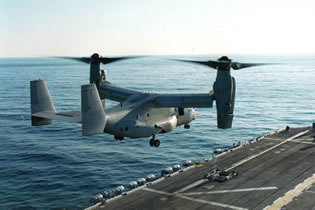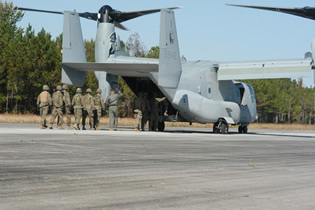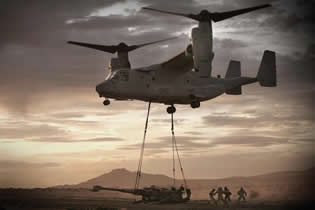V-22 Osprey Bell Boeing
| a | ||||||||||||||||||||||||
|
Bell-Boeing V-22/MV-22 Osprey Tiltrotor Aircraft Helicopter
|
||||||||||||||||||||||||
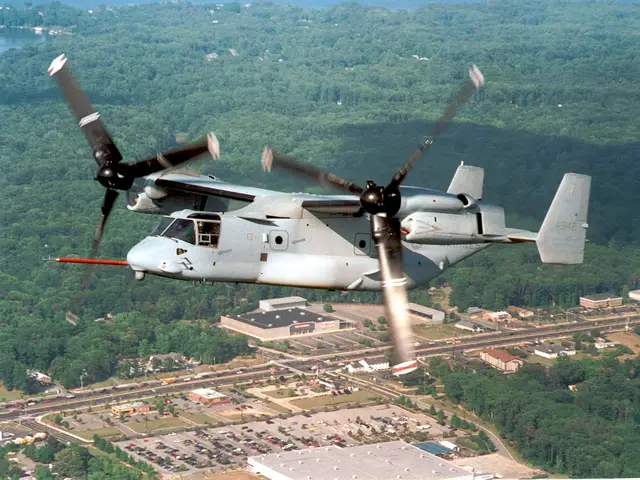 |
||||||||||||||||||||||||
 |
||||||||||||||||||||||||
|
|
||||||||||||||||||||||||
|
|
||||||||||||||||||||||||
|
Produced by two major manufacturers Bell and Boeing, the V-22 Osprey is a joint service multi-role combat aircraft utilizing tiltrotor technology to combine the vertical performance of a helicopter with the speed and range of a fixed wing aircraft. With its engine nacelles and rotors in vertical position, it can take off, land and hover like a helicopter. Once airborne, its engine nacelles can be rotated to convert the aircraft to a turboprop airplane capable of high-speed, high-altitude flight. |
||||||||||||||||||||||||
| Main Variants | ||||||||||||||||||||||||
|
Envisaged variants: |
||||||||||||||||||||||||
| Technical Data | ||||||||||||||||||||||||
| Design | ||||||||||||||||||||||||
|
The Osprey is the world's first production tiltrotor aircraft, with one three-bladed proprotor, turboprop engine, and transmission nacelle mounted on each wingtip. It is classified as a powered lift aircraft by the Federal Aviation Administration. For takeoff and landing, it typically operates as a helicopter with the nacelles vertical and rotors horizontal. Once airborne, the nacelles rotate forward 90° in as little as 12 seconds for horizontal flight, converting the V-22 to a more fuel efficient, higher speed turboprop aircraft. STOL rolling-takeoff and landing capability is achieved by having the nacelles tilted forward up to 45°. Other orientations are possible, such as the "80 Jump" takeoff which uses nacelles at 80° to quickly achieve high altitude and speed.
|
||||||||||||||||||||||||
| Avionics and equipment | ||||||||||||||||||||||||
|
The V-22 is equipped with a glass cockpit, which incorporates four Multi-function displays (MFDs, compatible with night-vision goggles) and one shared Central Display Unit (CDU), allowing the pilots to display a variety of images including: digimaps centered or decentered on current position, FLIR imagery, primary flight instruments, navigation (TACAN, VOR, ILS, GPS, INS), and system status. The flight director panel of the Cockpit Management System (CMS) allows for fully coupled (autopilot) functions that take the aircraft from forward flight into a 50 ft (15 m) hover with no pilot interaction other than programming the system
|
||||||||||||||||||||||||
| Propulsion | ||||||||||||||||||||||||
|
The V-22's two Rolls-Royce AE 1107C engines are connected by drive shafts to a common central gearbox so that one engine can power both proprotors if an engine failure occurs. However, if a proprotor gearbox fails that proprotor cannot be feathered, and both engines must be stopped before an emergency landing. The V-22 can also be refuel in flight to increase its operational range.
|
||||||||||||||||||||||||
| Armament | ||||||||||||||||||||||||
|
The Osprey can be armed with one 7.62x51mm NATO (.308 in caliber) M240 machine gun or .50 in caliber (12.7 mm) M2 machine gun on the loading ramp, that can be fired rearward when the ramp is lowered. A .50 in GAU-19 three-barrel Gatling gun mounted below the V-22's nose was studied for future upgrade. BAE Systems developed a belly-mounted, remotely operated gun turret system for the V-22, named the Interim Defense Weapon System. This system is remotely operated by a gunner inside the aircraft, who acquires targets with a separate pod using color television and forward looking infrared imagery. The belly gun system was installed on half of the first V-22s deployed to Afghanistan in 2009, but found limited use due to its 800 lb (360 kg) weight and restrictive rules of engagement
|
||||||||||||||||||||||||
| Specifications | ||||||||||||||||||||||||
|
||||||||||||||||||||||||
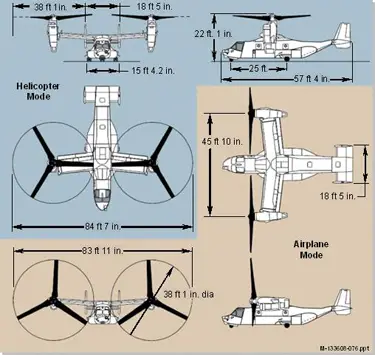 |
||||||||||||||||||||||||
|
||||||||||||||||||||||||



























